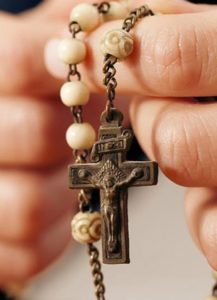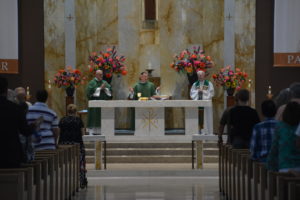Contemplation before the Shroud and Mass in Piazza Vittorio
By VISarchive 02
Vatican City, 21 June 2015 (VIS) – After his encounter with representatives from the world of work, the Pope proceeded on foot to the Cathedral of St. John the Baptist, which houses the Holy Shroud, traditionally considered to have been wrapped around the body of Christ after his crucifixion. As Roberto Gottardo, president of the diocesan Commission for the Shroud, writes: “The Shroud is a cloth, but it is above all an image. … This image tells us of Jesus, in an immediate way, before science can offer its version and before faith reveals that it is Jesus. All this does not mean that the Shroud is certainly the sheet brought by Joseph of Arimathea below the cross, but certainly anyone who looks at it will find that it immediately recalls this story”. During the exposition of the Shroud in 1998, St. John Paul II affirmed: “The Shroud is also an image of human suffering, that experience that is to varying extents part of the existence of every person, and allows us to recognise this man as one of us”.
Once inside the Cathedral, the Pope knelt before the Holy Shroud, displayed at the major altar, in order to meditate for a moment in the presence of the elder priests of the Cathedral and cloistered nuns. He then proceeded to the chapel that houses the relics of Blessed Pier Giorgio Frassati (1901-1925), from Turin. Shortly after 10 a.m. he left the Cathedral and travelled by popemobile to Piazza Vittorio, one of the largest squares in Europe, to celebrate Holy Mass before thousands of people and to pray the Angelus.
“The readings we have heard should us how God’s love for us is a faithful love, a love that recreates everything, a stable and secure love”, said Francis in his homily. “It is a love that does not deceive us, that never ends. Jesus incarnates that love: it is his Testament. He never ceases to love us, to support us, to forgive us, and so it leads us down the path of life, according to the promise He made to His disciples: ‘I am with you always, to the end of the age’. Jesus remains faithful, even when we make mistakes, and he awaits us to forgive us: He is the face of the merciful Father. He is faithful love”.
“The second aspect: the love of God recreates everything, it makes all things new. … Acknowledging our limits and weaknesses is the door that opens up to Jesus’ forgiveness, to His love that can renew us profoundly and can recreate us. Salvation can enter into the heart when we open up to the truth and acknowledge our errors, our sins; it is then that we have that beautiful experience of Him, of He who came not for the healthy, but for the sick; not for the righteous, but for sinners. … The sign that we have become ‘new’ and have been transformed by God’s love is knowing how to cast aside the worn and old robes of rancour and enmities, to re-clothe us in the clean tunic of meekness, benevolence, service to others, and the peace of the heart proper to the sons of God. … God’s love is stable and secure … as Jesus shows in the miracle narrated in the Gospel, when He calms the storm, commanding the wind and the sea. The disciples are afraid as they realise they are not able to cope, but He opens their heart to the courage of faith. To the man who cries, ‘I can’t do it any more’, the Lord reaches out, offering him the rock of His love, to which anyone can hold, sure of not falling”.
“We can ask ourselves if today we rest firmly on the rock that is God’s love; whether we live God’s faithful love for us. There is always the risk of forgetting that great love the Lord has shown to us. We Christians too run the risk of letting ourselves be paralysed by fears of the future and seeking security in transient things, in a model of a closed society that tends to exclude more than it includes”.
“May the Holy Spirit help us always to be conscious of this love that, like a rock makes us stable and strong in sufferings small and great; that makes us able not to close ourselves up when faced with difficulties, to face life with courage and to look to the future with hope. As then, on the lake of Galilee, today too in the sea of our existence Jesus is He Who vanquishes the forces of evil and the threats of despair. The peace He gives us is for all; even for many brothers and sisters who flee from wars and persecutions in search of peace and freedom”.
Following Mass, and before praying the Angelus, the Pope recalled that the Shroud, which attracts millions of pilgrims to Turin every year, was the icon of Jesus’ love. “The Shroud attracts us through the face and the broken body of Jesus and, at the same time, drives us towards the face of every suffering and unjustly persecuted person. It drives us in the same direction of the gift of Jesus’ love. ‘The love of Christ impels us’: these words of St. Paul’s were the motto of St. Joseph Benedict Cottolengo”.
“Recalling the apostolic zeal of many priests, saints of this land, starting from Don Bosco, of whom we recall the bicentenary of his birth, I greet you, priests and men and women religious. You dedicate yourselves fully to pastoral work and you are close to the people and their problems. I encourage you to continue in your ministry with joy, always focusing on what is essential in the announcement of the Gospel. And while I thank you, brother bishops of Piedmont and Valle d’Aosta, for your presence, I exhort you to stay near to your priests with paternal affection and warm closeness”.
“To the Holy Virgin I commend this city, her territory and all who live here, so that they may live in justice, in peace and in fraternity. In particular, I entrust families, the young, the elderly, the imprisoned and all those who suffer, with a special thought for those who suffer from leukaemia today, on National Day Against Leukaemia, Lymphoma, and Myeloma. May Mary the Consoler, the Queen of Turin and Piedmont, keep firm your faith, assure your hopes and make your charity fruitful, so as to be ‘salt and light’ of this blessed land, of which I am a grandson”.
Following the Marian prayer, the Pope transferred to the archbishop’s residence by car, greeting the soldiers of the Training School, where he lunched with the detainees of the “Ferrante-Aporti” prison for minors, some immigrants and various people without fixed abode.
Source:: Vatican Information Service
Categories
From the Desk of Fr. JohnSs. Peter & Paul NewsU.S. Conf. of Catholic BishopsVatican Information ServiceWhat's HappeningUpcoming Events



